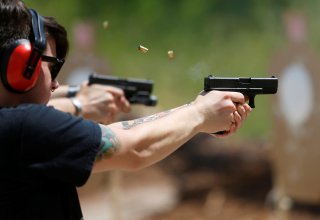Keep It in the Family: Carrying and Competing With Similar Pistols
Staying within the same platform or family of pistols can go a long way in making you a more consistent shooter.
Have you considered the advantages of training, competing, and carrying pistols within the same family? I define a “family of pistols” as pistols that have similar grip angles, controls, sighting systems, and other elements. For example, Glock pistols, the SIG P320 and P365, 1911s, and the Springfield XD series would all fall within the same family of pistols.
In late 2014, a friend and I set a goal of successfully shooting Master in every International Defensive Pistol Association (IDPA) Division available at that time. We ultimately achieved our goal. Facing this challenge, we were generally practicing one to three times a week and firing an average of 200 to 300 rounds per practice session. We competed in the IDPA division that we were striving to master (no pun intended).
As we achieved Master in each division, we moved on to the next. Through the course of our training, we developed a feel for the differences between the pistol types we were using in the different divisions and realized that staying within the same platform or family of pistols was extremely important for consistency.
For me, this fact slammed home when I decided to experiment with a Glock 19 equipped with a Trijicon RMR while simultaneously training and competing with a four-inch Springfield XD with a match trigger and fiber optic sights. IDPA had no carry optic division at that time.
Attempting to train with two different platforms set me back considerably, as my brain tried to adjust to the differences between the grip angles, sighting systems, slide and magazine release locations, and other unique factors of the two different pistol families. Rather than progressing, my shooting actually began to suffer. As a result, I stopped using the Glock and concentrated on training with the XD.
We both routinely carried legally concealed and realized that our carry pistol and holster needed to match the IDPA Division we were training. If not, we were very likely to foul the draw if we had to present the pistol in a self-defense situation. We started carrying revolvers when we were working on the revolver division and switched to back-up guns when training for that division—the list goes on.
After completing our IDPA Master challenge and competing in the 2016 IDPA Nationals, I spent the next few years focusing exclusively on improving my self-defense skills and maintaining my skills with my carry pistols. I set up two essentially identical SIG P320 carry pistols with the same sighting system, holster, and trigger pulls. I trained and competed with one pistol and carried the other, rotating the pistols and carry ammunition every six months. I used the old carry ammunition to reconfirm the new carry pistol’s zero. I used my training pistol and my everyday carry (EDC) holster in all of my practice, training, and competition.
The same concept applies to holster tilt, angle, positioning, and other characteristics. Ideally, the holster should be in the same place and approximately the same height on the belt for competition and carry. My EDC concealed carry holster rides higher on the belt and is not as fast as typical competition holsters, which generally sit one to two inches lower. I once discovered that after a period of training for a competition, I often missed my draw with my EDC holster when my hand automatically went to the lower location where the competition holster would have been on my belt. This poses a challenge to those who wish to use appendix or abdominal carry, as many competitions do not permit appendix carry for liability reasons. Consistent and routine dry practice with your appendix carry rig is very important if you compete with a strong side holster.
Another option is to compete with and carry a holster that meets IDPA standards. For a number of years, my EDC holster was the same IDPA-legal holster I used in competition. I eventually found this to be problematic because it protruded far enough out from my belt that I routinely bumped the pistol and holster into objects. As a result, I stopped using the IDPA holster in favor of one that pulled the pistol closer to my body and solved this problem.
Choosing a pistol family and then sticking within that family for competition and carry will go a long way toward improving our shooting skills. I routinely see students and competitors practicing, training, and competing with multiple pistol families and holster positions. They will bring a SIG P320 X5 to a class, use an upgraded 1911-based race gun in competition, and then carry a Smith and Wesson Shield in an inside the waistband holster. For instance, I once had a student who brought a different pistol family to every class. Needless to say, he never mastered any pistol, and his shooting ability did not appreciably improve.
Ultimately, regardless of your shooting goals and which method of carry you chose, consistent and regular dry practice with your EDC pistol family and holster will ensure that it is where you expect it to be if you must draw it in an emergency.
Eric Lamberson is a firearms trainer and expert with over forty years of experience. He has completed the Force Science Institute certification in Force Science Analysis and routinely writes about firearms and self-defense.
Image: Reuters.

